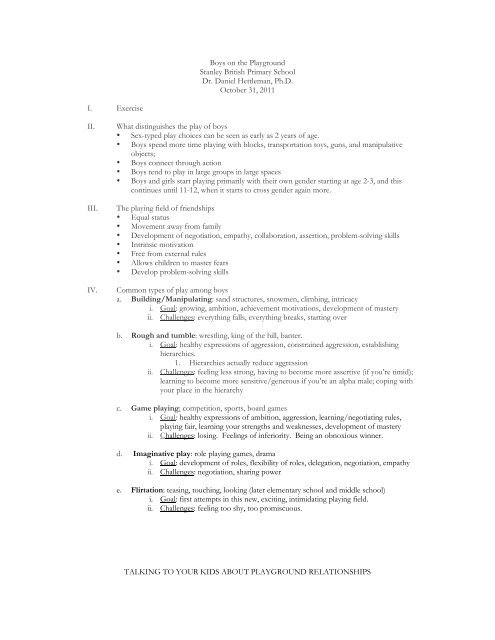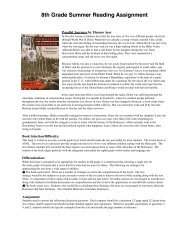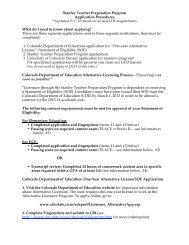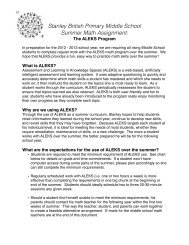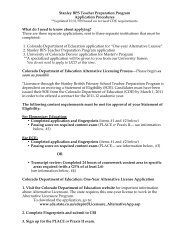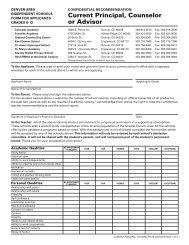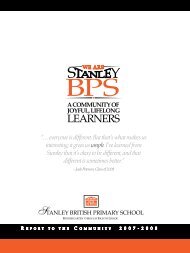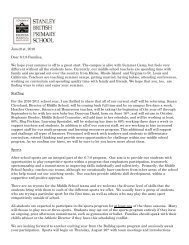Copies of the handouts from each presentation are available here.
Copies of the handouts from each presentation are available here.
Copies of the handouts from each presentation are available here.
Create successful ePaper yourself
Turn your PDF publications into a flip-book with our unique Google optimized e-Paper software.
Boys on <strong>the</strong> Playground<br />
Stanley British Primary School<br />
Dr. Daniel Hettleman, Ph.D.<br />
October 31, 2011<br />
I. Exercise<br />
II.<br />
III.<br />
IV.<br />
What distinguishes <strong>the</strong> play <strong>of</strong> boys<br />
• Sex-typed play choices can be seen as early as 2 years <strong>of</strong> age.<br />
• Boys spend more time playing with blocks, transportation toys, guns, and manipulative<br />
objects;<br />
• Boys connect through action<br />
• Boys tend to play in large groups in large spaces<br />
• Boys and girls start playing primarily with <strong>the</strong>ir own gender starting at age 2-3, and this<br />
continues until 11-12, when it starts to cross gender again more.<br />
The playing field <strong>of</strong> friendships<br />
• Equal status<br />
• Movement away <strong>from</strong> family<br />
• Development <strong>of</strong> negotiation, empathy, collaboration, assertion, problem-solving skills<br />
• Intrinsic motivation<br />
• Free <strong>from</strong> external rules<br />
• Allows children to master fears<br />
• Develop problem-solving skills<br />
Common types <strong>of</strong> play among boys<br />
a. Building/Manipulating: sand structures, snowmen, climbing, intricacy<br />
i. Goal: growing, ambition, achievement motivations, development <strong>of</strong> mastery<br />
ii. Challenges: everything falls, everything breaks, starting over<br />
b. Rough and tumble: wrestling, king <strong>of</strong> <strong>the</strong> hill, banter.<br />
i. Goal: healthy expressions <strong>of</strong> aggression, constrained aggression, establishing<br />
hierarchies.<br />
1. Hierarchies actually reduce aggression<br />
ii. Challenges: feeling less strong, having to become more assertive (if you’re timid);<br />
learning to become more sensitive/generous if you’re an alpha male; coping with<br />
your place in <strong>the</strong> hierarchy<br />
c. Game playing: competition, sports, board games<br />
i. Goal: healthy expressions <strong>of</strong> ambition, aggression, learning/negotiating rules,<br />
playing fair, learning your strengths and weaknesses, development <strong>of</strong> mastery<br />
ii. Challenges: losing. Feelings <strong>of</strong> inferiority. Being an obnoxious winner.<br />
d. Imaginative play: role playing games, drama<br />
i. Goal: development <strong>of</strong> roles, flexibility <strong>of</strong> roles, delegation, negotiation, empathy<br />
ii. Challenges: negotiation, sharing power<br />
e. Flirtation: teasing, touching, looking (later elementary school and middle school)<br />
i. Goal: first attempts in this new, exciting, intimidating playing field.<br />
ii. Challenges: feeling too shy, too promiscuous.<br />
TALKING TO YOUR KIDS ABOUT PLAYGROUND RELATIONSHIPS


